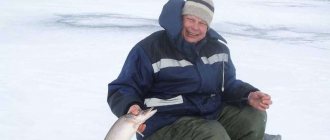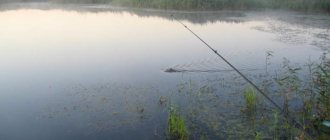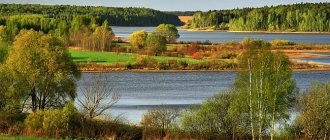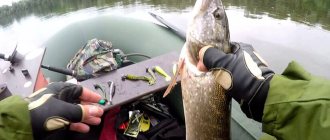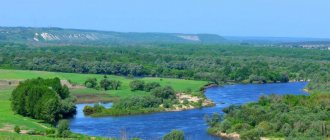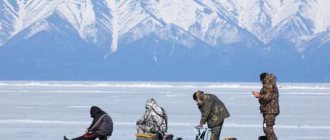General forecast for biting peaceful and predatory fish in the city of Yelets (Russia)
Favorable phase of the moon for peaceful fish: good bite for peaceful fish.
Good moon phase for predatory fish: excellent bite for predatory fish.
Good moon phase for peaceful fish: excellent bite for peaceful fish.
Good moon phase for predatory fish: excellent bite for predatory fish.
Good moon phase for peaceful fish: excellent bite for peaceful fish.
Good moon phase for predatory fish: excellent bite for predatory fish.
Good moon phase for peaceful fish: excellent bite for peaceful fish.
Good moon phase for predatory fish: excellent bite for predatory fish.
BITING FORECAST FOR PEACEFUL FISH IN THE CITY OF ELETS
Today - Thursday - nightBite of peaceful fish Positive factors: + Favorable phase of the moon for peaceful fish: good bite of peaceful fish. + The fish bite is better on grey, cloudy days. + Good fish bite when the wind blows from the west, south, east. + A slight breeze is very favorable for fishing. + Stable wind direction. + Low atmospheric pressure has a beneficial effect on fish biting. + Stable low atmospheric pressure.
Negative factors: - At this time of year, fish, as a rule, do not bite. You can count on a normal bite from bream and roach.
Today - Thursday - morningBite of peaceful fishPositive factors: + Favorable phase of the moon for peaceful fish: good bite of peaceful fish. + Good fish bite when the wind blows from the west, south, east. + A slight breeze is very favorable for fishing. + Stable wind direction. + Low atmospheric pressure has a beneficial effect on fish biting. + Stable low atmospheric pressure.
Negative factors: - At this time of year, fish, as a rule, do not bite. You can count on a normal bite from bream and roach. — Bad weather makes the fish feel uncomfortable.
Today - Thursday - day Biting peaceful fish Positive factors: + Favorable phase of the moon for peaceful fish: good biting peaceful fish. + In clear weather, as a rule, the fish feels comfortable. + Good fish bite when the wind blows from the west, south, east. + A slight breeze is very favorable for fishing. + Stable wind direction. + Low atmospheric pressure has a beneficial effect on fish biting. + Stable low atmospheric pressure.
Negative factors: - At this time of year, fish, as a rule, do not bite. You can count on a normal bite from bream and roach.
Today - Thursday - eveningBite of peaceful fishPositive factors: + Favorable phase of the moon for peaceful fish: good bite of peaceful fish. + As a rule, a little rain can activate the fish bite. + Good fish bite when the wind blows from the west, south, east. + A slight breeze is very favorable for fishing. + Stable wind direction. + Low atmospheric pressure has a beneficial effect on fish biting. + Stable low atmospheric pressure.
Negative factors: - At this time of year, fish, as a rule, do not bite. You can count on a normal bite from bream and roach.
Tomorrow - Friday - nightBite of peaceful fish Positive factors: + Good phase of the moon for peaceful fish: excellent bite of peaceful fish. + As a rule, a little rain can activate the fish bite. + Today the direction of the wind does not affect the fish bite. + A slight breeze is very favorable for fishing. + Stable wind direction. + Low atmospheric pressure has a beneficial effect on fish biting. + Stable low atmospheric pressure.
Negative factors: - At this time of year, fish, as a rule, do not bite. You can count on a normal bite from bream and roach.
Tomorrow - Friday - morningBite of peaceful fishPositive factors: + Good phase of the moon for peaceful fish: excellent bite of peaceful fish. + Today the direction of the wind does not affect the fish bite. + A slight breeze is very favorable for fishing. + Stable wind direction. + Low atmospheric pressure has a beneficial effect on fish biting. + Stable low atmospheric pressure.
Negative factors: - At this time of year, fish, as a rule, do not bite. You can count on a normal bite from bream and roach. — Bad weather makes the fish feel uncomfortable.
Tomorrow - Friday - day Biting of peaceful fish Positive factors: + Good phase of the moon for peaceful fish: excellent biting of peaceful fish. + The fish bite is better on grey, cloudy days. + Good fish bite when the wind blows from the west, south, east. + A slight breeze is very favorable for fishing. + Stable wind direction. + Low atmospheric pressure has a beneficial effect on fish biting.
Bite forecast methodology
This forecast is based on an assessment of the state of the ichthyofauna depending on changes in meteorological quantities and the influence of the phases of the moon. The algorithm does not use any controversial dependencies (which may vary depending on the region, environmental situation, water level, etc.).
The bite forecast is available on many fishing sites, some easier, some more difficult, but in most cases users are offered a certain result of “dancing with a tambourine.” In order to form unambiguously correct dependences of the bite of a particular type of fish in a particular region (and take responsibility for predicting the bite of a particular type of fish) with reference to the calendar, it is necessary to collect and process enormous amounts of data. In this case, it is necessary to take into account both natural factors (spawning time, weather anomalies) and human intervention (water level regulation, warm runoff, discharge of chemicals, etc.). It is safe to say that no one has detailed statistics and collecting them is useless, because... Such data quickly becomes outdated and loses relevance. It is known that in the same region the biting situation can change dramatically within just a couple of years (with the exception of places that are difficult for humans to reach).
It is for the reasons described above that the bite forecast at Fish Hoek is not formed on the basis of some “averaged statistical data”. Over thousands of years, humanity has studied quite well the general principles of the influence of weather and the moon on living organisms. These principles are used in the given algorithm. Moreover, the bite forecast must take into account not only the condition of the object being fished, but also the fisherman himself, because the result of fishing also depends on the well-being (and therefore the mood) of the fisherman.
The forecast does not take into account the size/weight/age of the fish: just as we ourselves are less weather dependent in our youth, small fish can be active in almost any weather.
The bite is predicted only a few days in advance (on days for which we can get reliable weather reports).
Catching dace at different times of the year
Dace is a small, peaceful fish of the carp family, sedentary and schooling. Externally, dace looks like a small chub or bleak. It has a laterally compressed elongated body. The scales of the dace are silvery, on the back they are gray-blue, and on the belly they are silvery-white. The size of the scales is average. The fins are transparent gray, the lower ones are yellowish or buffy. During spawning, the abdominal and pectoral parts of males become reddish. The head is narrow, the mouth is small and semi-lower, the eyes are large, but not excessively. Dace has several subspecies that differ slightly from each other.
Dace is a small fish. The maximum size of a dace can reach forty centimeters, its weight is one kilogram, most often the caught dace has more modest dimensions - the length does not exceed twenty centimeters and it weighs about two hundred grams. The maximum lifespan is not about sixteen years.
Dace habitats
Elets has several subspecies: ordinary, Siberian, Kyrgyz, Transcaspian, Talas, Danilevsky, Zeravshan. Dace is found in water bodies of Europe, Western Siberia and Central Asia. The ideal habitat for dace is a clean forest river with a good flow. In the absence of such a river, it lives in flowing reservoirs with clean water. Dace loves a clean bottom, sandy or rocky, with pools and snags, and never settles in silted reservoirs without a current.
The dace's diet includes plankton, larvae, worms, insects, foreign eggs and underwater vegetation, of which it especially loves mulberry.
Siberian dace is a commercial fish.
Let's start by finding fish
Like many other species that live in small rivers, dace loves clean water, so you need to look for it closer to the stream, or in pools with a reverse flow, where microorganisms, plankton and other goodies accumulate. It also makes sense to look for spruce on the border of underwater vegetation. In places without a current, in bushes close to the shore, bites will be much less frequent, and the specimens you will find, to put it mildly, are not trophy - it has been experimentally found that the largest individuals try to stay close to the stream.
Dace is not a bottom-dwelling fish; most often it stands halfway in the water, but when catching it, we still examine all horizons, from tapping on the bottom to practically lifting the bait into the hole. It is not uncommon for a fish to take bait right next to the ice. But sometimes, especially in the frosty depths of winter, when the fish are completely inactive, dace is caught only by the sluggish swaying of the jig at the very bottom.
Features of catching dace
Dace is one of the few fish that can be caught all year round, but intense biting begins only after the flight of aerial insects. Dace is best caught in the daytime, in the current and near rifts, in cool weather - from ten to twenty degrees Celsius and at normal atmospheric pressure. The worst time to catch dace is when the weather changes, during the new moon, full moon and after rain. Bait is quite effective, but not necessary. We should not forget that dace is a very cautious, timid and nimble fish.
Catching dace in winter
Although the dace bites all winter, it does so quite passively. In December, it is quite good (for winter, of course) in the first ice in good clear weather. In January and early February, the bite is the worst - the dace is passive due to lack of oxygen. From the end of February the bite intensifies.
Catchable jigs for catching dace
When catching dace with a jig, the following types of fishing tackle are used:
- Flat drop. The pendant has a green stop ball, a red bead and an orange ring on the hook.
- An elongated droplet. Used for catching dace in the current.
- Volumetric droplet. Light and light jig.
- Fishing tackle in the shape of an ant larva (heavyweight). It is better to use it during the thaw period.
Game of bait and fishing
Fishing methods are as follows:
- You should not make sudden movements with your hand, as the dace’s lips can easily tear.
- During periods of low fish activity, the bite may not be noticed, as the dace tries to pull off the bloodworm without touching the hook. Therefore, you should periodically shake the bait with the tip of the rod. A game like this will ensure a good catch.
- After landing 3 fish, the dace stops biting. Therefore, you should change your fishing location. You can return to your original fishing spot in an hour.
How to fish in the current
Biting of large dace is possible provided that a number of rules are followed:
- The lower jig should be heavier, but the upper one can remain light, since thanks to such a jig you can attract the attention of the dace.
- It is important to pull the line upward, during which both jigs play.
- Moving the bait along the bottom is also a good technique for catching dace.
- Using a plant attachment.
- The main task of bait is to create an invisible trail of odors at a distance of 3 m downstream from the fishing zone.
Fish biting forecast for five days.
Our 5-day fish bite forecast takes into account all the most important constant and predictable data:
- the influence of the moon (the influence of the phases of the moon on the bite is still a controversial issue, but experience shows that it exists and should not be neglected when making a bite forecast for 5 days);
- physiology and behavior of each fish individually (its activity, passivity, spawning, peaceful, predatory, diurnal, nocturnal, etc.);
- time of day and seasons;
- weather conditions and pressure changes according to the weather forecast;
- and other factors that affect the appetite and bite of fish.
Fishing on the Don in the Lipetsk region 2018
Fishing in the Lipetsk region!
Comments
With such roach there is no need for bream
